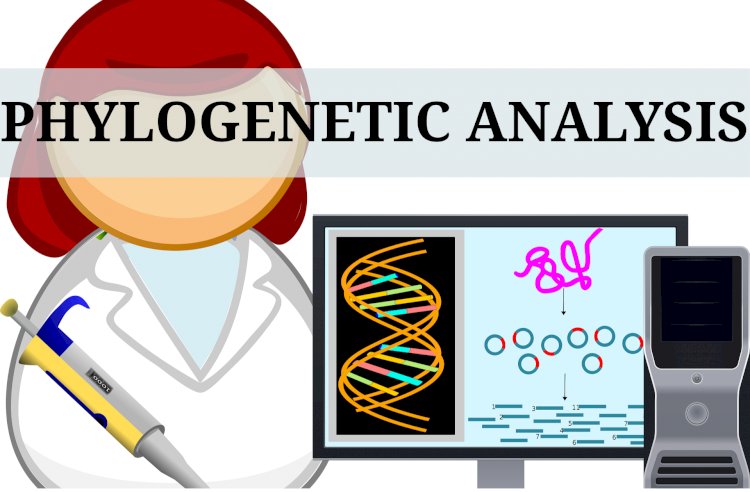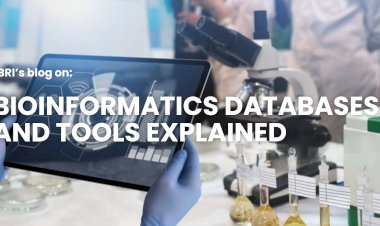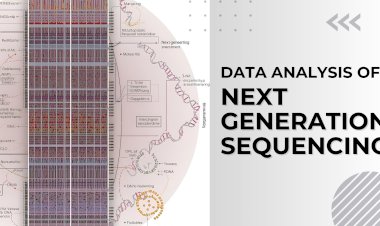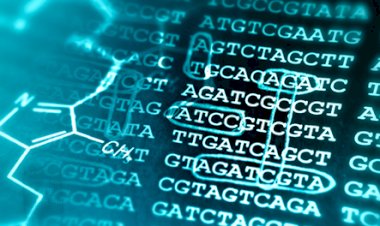PHYLOGENETIC ANALYSIS: METHODS, TOOLS, AND CAREERS
Phylogenetic analysis plays a crucial role in understanding the evolutionary relationships between species by examining genetic data. Using bioinformatics tools like MEGA, RAxML, and MrBayes, researchers can construct phylogenetic trees, aligning sequences, selecting evolutionary models, and analyzing genetic variations. This method has broad applications, from enhancing biodiversity studies and refining taxonomy to tracking disease evolution and developing vaccines. As the field grows, bioinformaticians and computational biologists with expertise in phylogenetic analysis are in high demand, offering exciting career opportunities in research, healthcare, and biotechnology.

PHYLOGENETIC ANALYSIS: METHODS, TOOLS, AND CAREERS
One of the biggest problems facing modern biology is comprehending the evolutionary links between organisms. The examination of these links, known as phylogenetic analysis, has historically been carried out by hand utilizing physical characteristics and morphological attributes. But the advent of bioinformatics tools, which offer strong computational techniques for analyzing enormous genomic data sets, has completely changed this discipline. This blog examines the expanding job options in this quickly developing subject as well as the application of bioinformatics techniques in phylogenetic research.
What is Phylogenetic Analysis?
Prior to exploring bioinformatics tools, it is crucial to understand the fundamentals of phylogenetic analysis. One technique for figuring out the evolutionary links between species or genes is phylogenetic analysis. A phylogenetic tree, a branching diagram that illustrates how species have evolved from common ancestors, is frequently used to visualize this.
Understanding evolutionary routes and how species are related through common descent is the main objective of phylogenetic analysis. To create these evolutionary trees, modern methods analyze genetic data, including DNA, RNA, and protein sequences.
The Role of Bioinformatics in Phylogenetic Analysis
Bioinformatics tools have brought an entirely new dimension to phylogenetic analysis. They enable researchers to analyze vast amounts of genetic data quickly, accurately, and in ways that were previously not possible. Here's how bioinformatics plays a critical role in the process:
1. Data Collection and Sequence Alignment
Collecting genetic information from the species or genes under study is the initial stage in any phylogenetic analysis. Next-Generation Sequencing (NGS) and DNA sequencing are two methods used to get DNA sequences from different species. These sequences are then aligned using bioinformatics technologies to make sure they are equivalent. Because even a single alignment error might produce misleading findings, proper alignment is crucial for correct phylogenetic analysis.
- Tools for Sequence Alignment:
- Clustal Omega: A widely used tool for multiple sequence alignment.
- MAFFT: Another popular tool known for its fast and accurate sequence alignment.
- Muscle: A tool for multiple sequence alignment that provides high accuracy and speed.
2. Model Selection for Evolutionary Analysis
Once sequences are aligned, bioinformaticians must choose an appropriate evolutionary model. These models describe the patterns of genetic changes (e.g., nucleotide substitutions) that have occurred over time. Using an incorrect model can skew the results of the phylogenetic analysis.
- Tools for Model Selection:
- jModelTest: A popular software that helps researchers choose the best evolutionary model for their data.
- ProtTest: A tool used for selecting the best model of protein evolution.
3. Phylogenetic Tree Construction
The heart of phylogenetic analysis lies in constructing the phylogenetic tree. Various algorithms are employed to generate these trees based on the genetic data, using different methods, such as Maximum Likelihood (ML), Neighbor-Joining (NJ), and Bayesian Inference (BI).
- Tools for Tree Construction:
- MEGA (Molecular Evolutionary Genetics Analysis): A popular tool for building phylogenetic trees using different algorithms.
- RAxML (Randomized Axelerated Maximum Likelihood): One of the most widely used tools for Maximum Likelihood tree construction.
- MrBayes: A tool for Bayesian Inference of phylogenetic trees, widely used in molecular phylogenetics.
4. Tree Visualization and Interpretation
- Following tree construction, the data are visualized and interpreted using bioinformatics techniques. Researchers can evaluate tree reliability and gain a deeper understanding of evolutionary links with the use of visualizations. Tools may also offer statistical evaluations, like posterior probabilities or bootstrapping, to evaluate the tree's resilience.
- Tree Visualization Tools:
- FigTree: A graphical tool used for visualizing and editing phylogenetic trees.
- iTOL (Interactive Tree of Life): A popular web-based tool for the visualization, annotation, and management of phylogenetic trees.
5. Comparative Genomics
- Another crucial element of phylogenetic analysis is comparative genomics. The genomes of various animals are compared using bioinformatics methods to find genetic similarities and differences. These analogies shed important light on evolutionary processes including horizontal gene transfer and gene duplication.
- Tools for Comparative Genomics:
- BLAST (Basic Local Alignment Search Tool): A tool for comparing gene sequences and finding similarities between different species.
- Mauve: A tool for comparing multiple genomes and identifying genomic rearrangements.
Applications of Phylogenetic Analysis in Bioinformatics
Phylogenetic analysis, enhanced by bioinformatics tools, has a broad range of applications across various biological disciplines. Some key applications include:
1. Understanding Evolutionary History
Phylogenetic analysis is essential for understanding the evolutionary history of species, groups, and genes. It helps clarify how species have diverged from common ancestors over time.
2. Taxonomy and Classification
Phylogenetics plays a crucial role in modern taxonomy by helping classify species based on their genetic relationships. It is also used to revise outdated taxonomic classifications based on new genetic data.
3. Drug Discovery and Vaccine Development
In the study of pathogens, phylogenetic analysis helps track the evolution of viruses and bacteria, aiding in the development of vaccines and treatments. This is particularly important for rapidly mutating viruses like HIV, influenza, and SARS-CoV-2.
4. Conservation Biology
Phylogenetic analysis is used to assess the genetic diversity of endangered species. Understanding the evolutionary relationships of species can help conservationists prioritize which species need protection to maintain the overall biodiversity of ecosystems.
5. Microbial Evolution and Epidemiology
Phylogenetic analysis is crucial in studying microbial evolution. For example, tracking the genetic changes in bacterial populations can help epidemiologists track the spread of infections and antibiotic resistance.
Career Opportunities in Phylogenetics and Bioinformatics
As the use of bioinformatics tools in phylogenetic analysis grows, so does the demand for skilled professionals. Career opportunities in this field are diverse, ranging from academic research to industry roles in pharmaceuticals and healthcare. Here are some potential career paths:
1. Bioinformatician
Bioinformaticians examine biological data, such as genetic sequences, using computational techniques. Bioinformaticians create and implement pipelines for tree formation, model selection, and sequence alignment in the context of phylogenetics. They might be employed by biotech firms, universities, or research institutes.
2. Computational Biologist
Creating software tools and algorithms to evaluate intricate biological data is the main goal of computational biologists. They could concentrate on creating new techniques to investigate evolutionary processes or refining existing phylogenetic analysis tools.
3. Genomics Researcher
Genomics researchers focus on studying the genomes of different organisms. They use bioinformatics tools to compare genomes, identify evolutionary relationships, and explore the function of genes. This role is crucial in areas such as drug discovery, disease research, and environmental biology.
4. Epidemiologist
Epidemiologists use phylogenetic analysis to track the spread of infectious diseases, such as viruses and bacteria. By analyzing genetic data, they can trace outbreaks and predict future disease trends.
5. Bioinformatics Consultant
Bioinformatics consultants help academic and industry researchers implement bioinformatics pipelines, conduct phylogenetic analysis, and interpret results. They may work as independent contractors or as part of a consulting firm.
6. Clinical Bioinformatician
In healthcare, clinical bioinformaticians use phylogenetic analysis to study the genetic basis of diseases. They work closely with clinicians to understand genetic predispositions and develop personalized medicine strategies.
Skills Needed for a Career in Phylogenetics and Bioinformatics
To succeed in this field, individuals need a strong background in both biology and computational science. Key skills include:
- Proficiency in bioinformatics software (e.g., MEGA, RAxML, MrBayes).
- Understanding of molecular biology, genetics, and evolutionary theory.
- Programming skills, especially in languages like Python, R, or Perl.
- Knowledge of statistical analysis and data visualization tools.
- Ability to handle large datasets and use cloud computing for data storage and analysis.
IBRI Noida's Phylogenetic Analysis Training Program
The IBRI Noida offers an in-depth Phylogenetic Analysis Training Program designed to equip students and professionals with the skills needed for bioinformatics. The program provides hands-on experience with tools like MEGA, RAxML, and MrBayes, covering everything from sequence alignment to tree construction. Participants gain practical knowledge of phylogenetic analysis and its applications in research and healthcare. With expert guidance and personalized support, IBRI Noida helps students build the computational skills to implement these techniques in real-world scenarios. Whether you're an aspiring bioinformatician or looking to upskill, this program is a great opportunity to advance your career in bioinformatics.
Conclusion:
Our understanding of evolutionary biology has changed as a result of phylogenetic study employing bioinformatics techniques. Evolutionary linkages can now be explored in previously unthinkable ways by academics using computational methods in conjunction with molecular data. Those who are passionate about computational science and biology can find intriguing job prospects in this rapidly expanding subject.
Phylogenetics is an exciting and fulfilling discipline that offers countless opportunities for discovery, regardless of your interests—whether they are in detecting disease outbreaks, studying the evolutionary history of species, or creating novel medications and vaccines.
































